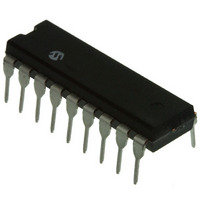PIC16F88-I/P Microchip Technology, PIC16F88-I/P Datasheet - Page 118

PIC16F88-I/P
Manufacturer Part Number
PIC16F88-I/P
Description
IC MCU FLASH 4KX14 EEPROM 18DIP
Manufacturer
Microchip Technology
Series
PIC® 16Fr
Datasheets
1.PIC16F616T-ISL.pdf
(8 pages)
2.PIC16F688T-ISL.pdf
(688 pages)
3.PIC16F818-ISO.pdf
(6 pages)
4.PIC16F87-IP.pdf
(228 pages)
5.PIC16F87-IP.pdf
(8 pages)
6.PIC16F87-IP.pdf
(4 pages)
7.PIC16F87-IP.pdf
(8 pages)
8.PIC16F88-ISO.pdf
(214 pages)
Specifications of PIC16F88-I/P
Program Memory Type
FLASH
Program Memory Size
7KB (4K x 14)
Package / Case
18-DIP (0.300", 7.62mm)
Core Processor
PIC
Core Size
8-Bit
Speed
20MHz
Connectivity
I²C, SPI, UART/USART
Peripherals
Brown-out Detect/Reset, POR, PWM, WDT
Number Of I /o
16
Eeprom Size
256 x 8
Ram Size
368 x 8
Voltage - Supply (vcc/vdd)
4 V ~ 5.5 V
Data Converters
A/D 7x10b
Oscillator Type
Internal
Operating Temperature
-40°C ~ 85°C
Processor Series
PIC16F
Core
PIC
Data Bus Width
8 bit
Data Ram Size
368 B
Interface Type
SSP/USART
Maximum Clock Frequency
20 MHz
Number Of Programmable I/os
16
Number Of Timers
3
Operating Supply Voltage
2 V to 5.5 V
Maximum Operating Temperature
+ 85 C
Mounting Style
Through Hole
3rd Party Development Tools
52715-96, 52716-328, 52717-734
Development Tools By Supplier
PG164130, DV164035, DV244005, DV164005, PG164120, ICE2000, DM163014
Minimum Operating Temperature
- 40 C
On-chip Adc
7-ch x 10-bit
Lead Free Status / RoHS Status
Lead free / RoHS Compliant
For Use With
ACICE0202 - ADAPTER MPLABICE 18P 300 MILAC164010 - MODULE SKT PROMATEII DIP/SOIC
Lead Free Status / Rohs Status
Lead free / RoHS Compliant
Available stocks
Company
Part Number
Manufacturer
Quantity
Price
Company:
Part Number:
PIC16F88-I/P
Manufacturer:
Microchi
Quantity:
6 825
Part Number:
PIC16F88-I/P
Manufacturer:
MICROCH
Quantity:
20 000
PIC16F87/88
The ADRESH:ADRESL registers contain the result of
the A/D conversion. When the A/D conversion is com-
plete, the result is loaded into the A/D result register
pair, the GO/DONE bit (ADCON0<2>) is cleared, and
A/D Interrupt Flag bit, ADIF, is set. The block diagram
of the A/D module is shown in Figure 12-1.
After the A/D module has been configured as desired,
the selected channel must be acquired before the con-
version is started. The analog input channels must
have their corresponding TRIS bits selected as inputs.
To determine sample time, see Section 12.1. After this
sample time has elapsed, the A/D conversion can be
started.
These steps should be followed for doing an A/D
conversion:
1.
FIGURE 12-1:
DS30487B-page 116
Configure the A/D module:
• Configure analog/digital I/O (ANSEL)
• Configure voltage reference (ADCON1)
• Select A/D input channel (ADCON0)
• Select A/D conversion clock (ADCON0)
• Turn on A/D module (ADCON0)
Converter
A/D
A/D BLOCK DIAGRAM
(Reference
(Reference
Voltage)
Voltage)
V
V
REF
REF
-
+
(Input Voltage)
VCFG1:VCFG0
VCFG1:VCFG0
V
IN
Preliminary
AV
AV
DD
SS
CHS2:CHS0
2.
3.
4.
5.
6.
7.
Configure A/D interrupt (if desired):
• Clear ADIF bit
• Set ADIE bit
• SET PEIE bit
• Set GIE bit
Wait the required acquisition time.
Start conversion:
• Set GO/DONE bit (ADCON0)
Wait for A/D conversion to complete, by either:
• Polling for the GO/DONE bit to be cleared
• Waiting for the A/D interrupt
Read A/D Result register pair
(ADRESH:ADRESL), clear bit ADIF if required.
For next conversion, go to step 1 or step 2 as
required. The A/D conversion time per bit is
defined as T
required before the next acquisition starts.
(with interrupts disabled); OR
110
101
100
011
010
001
000
AD
. A minimum wait of 2 T
2003 Microchip Technology Inc.
RB7/AN6/PGD/T1OSI
RB6/AN5/PGC/T1OSO/T1CKI
RA4/AN4/T0CKI/C2OUT
RA3/AN3/V
RA2/AN2/CV
RA1/AN1
RA0/AN0
REF
REF
+/C1OUT
/V
REF
-
AD
is




















